Article
Experts Argue COVID-19 Provides Opportunity to Implement Value-Based Care Practices
Author(s):
In a webinar, experts outlined challenges providers face amid the coronavirus disease 2019 (COVID-19) pandemic and the benefits of increased access to high-value care during the outbreak and beyond.
As the coronavirus disease 2019 (COVID-19) public health crisis continues to re-shape health care delivery—largely through increased utilization of telehealth services—advocates, payers, and providers are grappling with how best to navigate dramatic shifts in the system.
In a joint webinar, experts from the University of Michigan’s Center for Value-Based Insurance Design (V-BID) and the Smarter Health Care Coalition outlined challenges providers face amid the COVID-19 pandemic and the benefits of increased access to high-value care during the outbreak and beyond.
In early April, visits to ambulatory practices fell nearly 60% below the pre-COVID-19 baseline before rebounding in mid-June. However, rates plateaued at around 10% below baseline from then through the end of July, according to data presented by Michael Chernew, PhD, a founding partner of V-BID Health and co-editor-in-chief of The American Journal of Managed Care® (AJMC®).
Although all regions throughout the country experienced a drop in provider office visits, telemedicine utilization grew by 14% in the early months of the pandemic and has since remained at roughly 8% above baseline utilization.
In addition, rebounds in visitation rates in June and July varied by specialty. In areas such as pulmonology, orthopedics, and neurology the drop remains very significant, Chernew said, while decreases in visits will result in clinical ramifications. “But I’m not sure we have yet sorted out what those clinical ramifications are, and I think there’s going to be…a lot of interest in understanding what we’re losing in terms of health when all these visits went down,” he explained.
Despite the large uptick in hospital admissions for COVID-19 patients, data show these visits did not make up for the loss of routine procedures and other visits postponed or cancelled due to the pandemic. COVID-19 admissions also skew toward those with Medicare coverage, which results in lower payment rates for hospitals compared with commercially insured patients. Meanwhile, hospitals face increased costs due to reconfigurations of floors, excess need for personal protective equipment, and staffing shortages.
However, accelerated payments through CMS and allotments from the Coronavirus Aid, Relief, and Economic Security (CARES) Act have provided some financial relief to hospitals. “Some numbers that I’ve seen suggest that the money that’s been pumped into the system actually exceeds, at least so far, the added costs and the loss in revenue,” Chernew said.
It is still unknown how sustainable this temporary solution will be, especially as the country’s COVID-19 case numbers continue to climb. If facilities continue to operate with 10% lower volume, longer-term consequences for providers increase and uncertainties regarding continued governmental support abound.
As 40% to 50% of COVID-19 deaths have occurred in long-term care facilities, these centers also face uncertain financial futures, and, as Chernew points out, there can’t be postacute care without any acute care.
“We’re going to have to think about how those settings are going to respond in terms of consolidation, going out of business, and the financial viability of different parts of the sector,” he noted. All of these potential outcomes prompt concern about future access to care.
In total, Chernew predicts total health care spending will be about 5% below where it otherwise would have been in 2020. Due to “enormous” drops in unemployment, a large national deficit and a looming recession, employers may also reduce their generosity when it comes to providing coverage. And although insurers are spending less money, not all of those funds will be refunded to customers and most will likely go back to employers. Insurers could also face increased costs in the future as new treatments and tests for COVID-19 are developed.
When it comes to creating a more efficient health care system in the wake of COVID-19, Mark Fendrick, MD, director of V-BID and co-editor-in-chief of AJMC®, explained the importance of re-allocating money already within the health care system.
Low-value care—such as vitamin D screening, diagnostic tests before low-risk surgery, and low back pain imaging within 6 weeks of onset—costs stakeholders over $340 billion annually and yields little to no benefits to patients. Thus, realigning incentives discouraging wasteful spending on low-value care can create savings to be invested in high-value care.
“There are more clinically nuanced ways of coming out of the COVID-19 pandemic,” Fendrick stated. To transform the pandemic into a potential path to improve healthcare efficiency, he outlined the following strategies:
- Build on existing alternative payment models that base reimbursement on patient-centered outcomes, increase reimbursement for high-value services, and reduce or cease payment for known low-value care
- Leverage the widespread adoption of electronic health records (EHRs) to make it easier to order high-value care with simplified processes and discourage the use of low-value care with alerts
- Align patient cost-sharing with the value of the underlying services; reduce out-of-pocket cost on high-value services and increase patient cost on low-value care
Importantly, under the V-BID model, coverage can be enhanced for targeted high-value care without raising deductibles or premiums.
The concept has received bi-partisan support over the years, noted Katy Spangler, co-director of the Smarter Health Care Coalition, who also spoke during the webinar. And recently, a lot has happened within the V-BID space due in part to COVID-19, she stated. “It’s been really fascinating to see how quickly policy makers have worked to lower obstacles to high-value care during a pandemic.”
For example, in March, Internal Revenue Service notice 2020-15 was published, which allows health savings account–eligible high-deductible health plans to provide pre-deductible coverage of “medical care services and items purchased related to testing for and treatment of COVID-19.”
In addition, both the Families First Coronavirus Response Act and the CARES act have encouraged high-value care during the pandemic.




